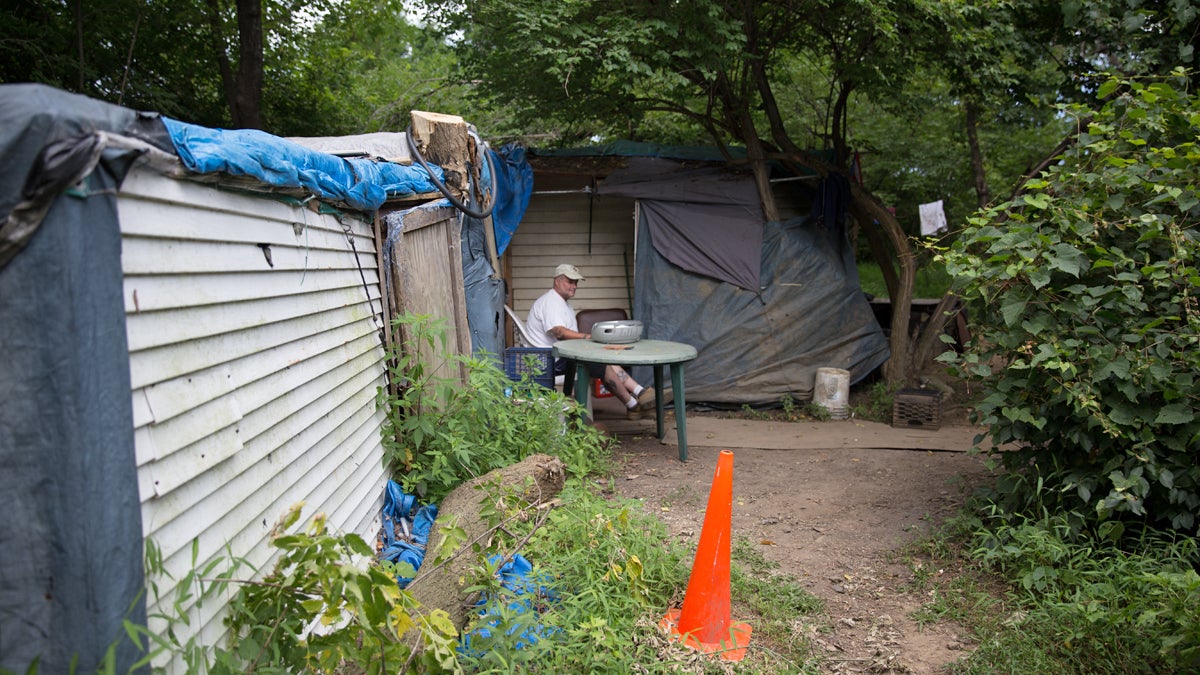More Pennsylvanians experiencing homelessness this year, opposing national trend

Dave Ritchie, a plumber by trade, lived in a shelter in the woods in Allentown, Pa. In Pennsylvania, the number of people living outside has increased since 2011. (Lindsay Lazarski/WHYY)
Pennsylvania does better helping some experiencing homelessness (veterans, for example) than others (families).
More than 15,400 Pennsylvanians experienced homelessness this year. That’s up slightly from 2014 – and up 6.2 percent from 2010, despite supportive housing and emergency shelter space increasing 2.5 percent statewide. Meanwhile, nationwide homelessness counts dropped as housing and shelter accomodations rose less than one percent, according to HUD data.
(Although housing’s increased a bit, rent remains expensive for many. Poverty, domestic violence or a combination of those and other factors also contribute, as Project HOME explains).
Those are some of the findings in the latest data on homelessness in the United States and an accompanying 80-page report released Thursday. The federal Department of Housing & Urban Development puts out the information every fall based on the annual Point-in-Time survey conducted simultaneously nationwide.*
Here are some of the other main takeaways:
Unsheltered
The number of people living outside (unsheltered) is increasing in the Commonwealth as it declines nationally, according to Keystone Crossroads’ analysis. HUD defines “unsheltered” as living in a place unfit for human habitation, such as cars, tent cities and bus stations. More than 1,400 were living outside this year — up from less than 1,000 in 2011 (the earliest year for which there’s data for all Pennsylvania continuums of care reporting now). That’s an increase of 44 percent in Pennsylvania since 2011, coinciding with a drop of 25 percent nationally.
Pittsburgh and Erie each saw a one-third decline. They were two of six regions with a decrease (also including Scranton and Harrisburg) versus nine increasing (including Philadelphia).
The number of unsheltered people in Reading/Berks County’s has also declined consistently — so much so that its proportion of people living outside (1 percent) is of the lowest among small city/county areas nationwide, according to the report.
Families
The HUD report found that Philadelphia, the nation’s fifth largest city, has one of the highest metropolitan populations of families experiencing homelessness: 2,652 (sixth behind LA, New York, Seattle, Boston and DC).
Keystone Crossroads found:• The figure accounts for 44 percent of Philadelphians experiencing homelessness. • Families make up the majority in six of 15 areas in Pennsylvania: York, Scranton, Eastern Pennsylvania and Bucks, Montgomery and Beaver counties.
Veterans experiencing homelessness
Chester County’s got one of the highest numbers of veterans experiencing homelessness (229) among smaller areas, while Philadelphia has one of the lowest rates (3 percent), according to the HUD report (both consistent with prior years). Keystone Crossroads found: • Philly’s rate is the second-highest in the state. Highest is in Bucks County. It’s 1 percent or less everywhere else in Pa., and just above the nationwide rate.• The numbers of veterans experiencing homelessness dropped nationally and statewide. • The number increased in Eastern Pennsylvania, York, and Chester and Bucks counties.
*Experts note the count is the nation’s only significant one, but misses people staying in their cars, motels, doubled-up , shelters that don’t get federal funding or places that are too hard to find.
This post has been updated to add a caveat about the annual point-in-time survey.
WHYY is your source for fact-based, in-depth journalism and information. As a nonprofit organization, we rely on financial support from readers like you. Please give today.



